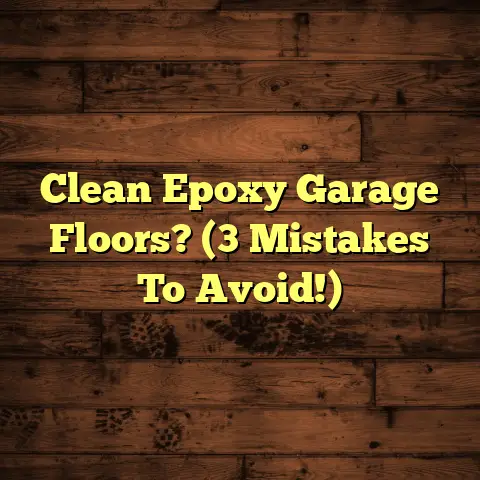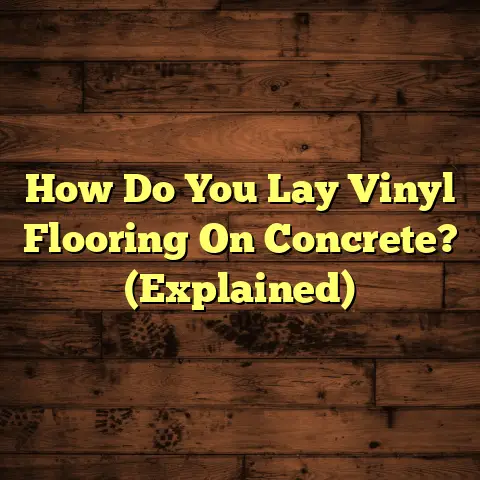Laminate or Vinyl? (1 Mistake Can Ruin Floors!)
And believe me, flooring is way more important than most people think.
It’s not just about looks (though that’s a big part, right?). It’s about comfort, durability, and how well your floors stand up to your life.
Laminate and vinyl? They’re the rockstars of modern flooring. Everyone’s talking about them.
They’re affordable, stylish, and come in a million different designs. But here’s the thing: one wrong move, one tiny mistake, and you could be looking at a flooring disaster.
Trust me, I’ve seen it happen.
Think warped planks, bubbling vinyl, and money down the drain. So, let’s dive in and make sure you don’t become one of those stories.
Section 1: Understanding Laminate Flooring
1.1 Definition and Composition
Okay, so what is laminate?
Basically, it’s a multi-layer synthetic flooring product fused together through a lamination process.
Think of it like a high-tech sandwich. You’ve got:
- The Backing Layer: This is the foundation, providing stability and moisture resistance.
- The Core Layer: Usually made of high-density fiberboard (HDF) or medium-density fiberboard (MDF), this gives the laminate its strength and thickness.
- The Design Layer: This is where the magic happens! A high-resolution image of wood, stone, or tile is printed on this layer, giving the laminate its realistic look.
- The Wear Layer: This is the top layer, a clear, protective coating that shields the design layer from scratches, stains, and fading.
1.2 Benefits of Laminate Flooring
Why is laminate so popular? Let me tell you:
- Affordability: Compared to hardwood or tile, laminate is super budget-friendly.
- Variety of Designs: Seriously, you can find laminate that looks like anything. From rustic oak to sleek marble, the options are endless.
- Ease of Installation: Many laminate floors feature a click-lock system, making them relatively easy to install yourself.
- Resistance to Scratches and Fading: That wear layer does its job! Laminate holds up well to everyday wear and tear.
1.3 Common Uses and Recommendations
Where does laminate shine? I typically recommend it for:
- Living Rooms: It’s durable enough for foot traffic and looks great.
- Bedrooms: It’s comfortable underfoot and adds warmth.
- Hallways: It can handle the constant comings and goings.
But… there are limitations.
I don’t recommend laminate for:
- Bathrooms: Unless it’s specifically a waterproof laminate. Regular laminate can swell and warp with moisture.
- Laundry Rooms: Same moisture issue as bathrooms.
1.4 Potential Pitfalls of Laminate Flooring
Okay, let’s talk about mistakes. Here are some common ones I see:
- Improper Acclimation: Laminate needs to adjust to the room’s temperature and humidity before installation. If you skip this, you’re asking for trouble.
- Insufficient Underlayment: Underlayment provides cushioning, sound insulation, and moisture protection. Don’t skimp on this!
- Neglecting Expansion Gaps: Laminate expands and contracts with temperature changes. You need to leave a small gap around the perimeter of the room to allow for this movement. Otherwise, your floor could buckle.
Section 2: Understanding Vinyl Flooring
2.1 Definition and Composition
Now, let’s talk vinyl. Vinyl flooring is a synthetic flooring made from polyvinyl chloride (PVC) and other compounds. It’s known for its water resistance and durability.
There are a few different types:
- Sheet Vinyl: Comes in large rolls, offering seamless installation.
- Vinyl Tile: Individual tiles that can be arranged in various patterns.
- Luxury Vinyl (LV): This is the premium option, offering realistic visuals and enhanced durability. It comes in planks (LVP) or tiles (LVT).
2.2 Benefits of Vinyl Flooring
Why choose vinyl? Here’s the lowdown:
- Water Resistance: This is vinyl’s superpower! It’s perfect for areas prone to moisture.
- Comfort Underfoot: Vinyl has a bit of give, making it more comfortable to walk on than harder surfaces like tile.
- Variety in Styles: Like laminate, vinyl comes in a huge range of colors, patterns, and textures.
- Low Maintenance: Vinyl is easy to clean and doesn’t require special treatments.
2.3 Common Uses and Recommendations
Where does vinyl excel? I often suggest it for:
- Bathrooms: Its water resistance makes it a no-brainer.
- Kitchens: Spills and splashes are no match for vinyl.
- Basements: Basements can be damp, so vinyl is a great choice.
2.4 Potential Pitfalls of Vinyl Flooring
Alright, let’s talk vinyl mistakes. Here are some I’ve encountered:
- Improper Subfloor Preparation: Vinyl needs a smooth, level subfloor. Any imperfections will show through.
- Neglecting to Allow for Expansion: Even though vinyl is more stable than laminate, it still needs a little room to breathe.
- Using the Wrong Adhesive: If you’re installing vinyl sheet or tile, using the wrong adhesive can lead to bonding issues.
Section 3: Key Comparisons Between Laminate and Vinyl
3.1 Durability and Wear Resistance
Okay, let’s get down to brass tacks.
- Laminate: Generally more scratch-resistant due to its tough wear layer. However, if it does get damaged, it’s harder to repair. Lifespan: 10-25 years.
- Vinyl: More resistant to dents and impacts. Easier to repair – you can often replace individual planks or tiles. Lifespan: 10-20 years.
3.2 Aesthetic Appeal
This is subjective, but here’s my take:
- Laminate: Can offer a more realistic wood look, especially high-end laminates with embossed textures.
- Vinyl: Has come a long way in terms of realism. Luxury vinyl can mimic wood, stone, and tile very convincingly.
3.3 Comfort and Noise Levels
- Laminate: Can be a bit noisy to walk on, especially with heels. Underlayment helps. Can feel colder underfoot.
- Vinyl: Softer and warmer underfoot. Absorbs sound better than laminate.
3.4 Installation Process
- Laminate: Click-lock systems make it relatively DIY-friendly. Requires precise cuts and attention to detail.
- Vinyl: Can also be DIY-friendly, especially with peel-and-stick tiles or planks. Sheet vinyl is best left to the pros.
Section 4: The Critical Mistake That Can Ruin Floors
4.1 Identifying the Mistake
Okay, here it is: the single biggest mistake I see that leads to flooring failure…
Improper subfloor preparation and/or failure to account for moisture.
I can’t stress this enough.
Your subfloor is the foundation of your entire flooring project. If it’s not level, clean, and dry, you’re setting yourself up for disaster.
And moisture? It’s the enemy of all flooring, but especially laminate.
4.2 Consequences of the Mistake
What happens when you mess up the subfloor or ignore moisture?
- Warping: Moisture causes laminate to swell and warp.
- Buckling: Uneven subfloors or expansion issues can cause floors to buckle.
- Premature Wear: Moisture can break down the adhesive in vinyl, leading to tiles or planks lifting.
- Mold and Mildew: Trapped moisture can create a breeding ground for mold and mildew, which is a health hazard.
4.3 Real-Life Case Studies
Let me tell you a couple of stories:
- The Laminate Nightmare: I had a client who insisted on installing laminate in their bathroom. I warned them against it, but they went ahead anyway. Within six months, the laminate was bubbling and warping around the toilet and shower. They had to rip it all out and start over with vinyl.
- The Vinyl Disaster: Another client tried to save money by skipping subfloor preparation. They installed vinyl tile over a cracked and uneven concrete slab. The cracks soon showed through the vinyl, and the tiles started to lift.
Section 5: Maintenance Practices to Prevent Mistakes
5.1 Routine Cleaning and Care
How do you keep your laminate or vinyl looking its best?
- Laminate: Sweep or vacuum regularly to remove dirt and debris. Use a damp mop with a laminate-specific cleaner. Avoid excessive water.
- Vinyl: Sweep or vacuum regularly. Mop with a vinyl-specific cleaner. Avoid abrasive cleaners.
5.2 Addressing Moisture Issues
- Use Dehumidifiers: In damp basements or other moisture-prone areas, use a dehumidifier to keep the air dry.
- Install Moisture Barriers: Before installing flooring, especially in basements, install a moisture barrier to prevent moisture from seeping up from the concrete slab.
- Fix Leaks Promptly: Address any leaks immediately to prevent water damage to your floors.
5.3 Periodic Maintenance and Inspection
- Regular Inspections: Check your floors regularly for signs of wear, damage, or moisture.
- Proactive Measures: If you notice any issues, address them promptly to prevent them from getting worse. Replace damaged planks or tiles. Re-seal grout lines.
Conclusion
So, there you have it. Laminate and vinyl are both great flooring options, but they’re not foolproof.
Remember that one critical mistake – improper subfloor preparation and/or failure to account for moisture – can ruin your entire flooring project.
Take the time to do your research, prepare your subfloor properly, and choose the right flooring for your environment.
Consider your lifestyle, your budget, and the specific needs of each room in your home.
And if you’re not sure, don’t be afraid to consult with a professional. It’s better to spend a little extra money upfront than to end up with a flooring disaster down the road.
Now go forth and floor with confidence!





